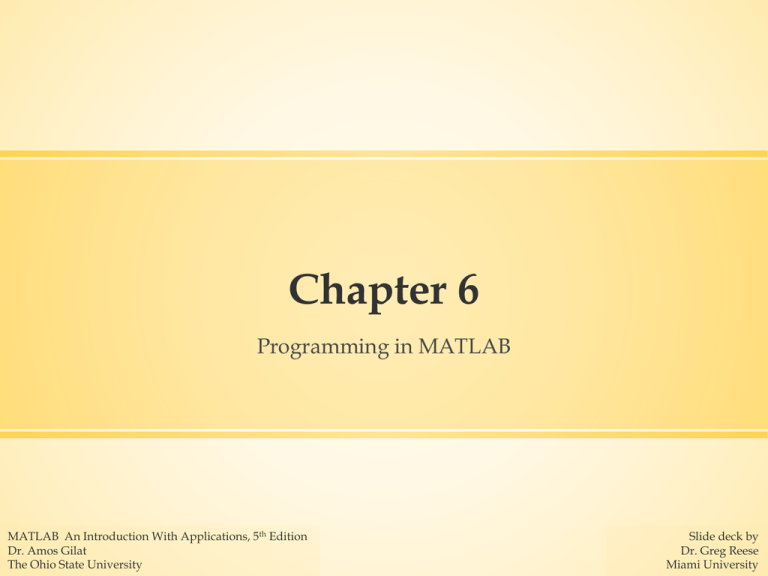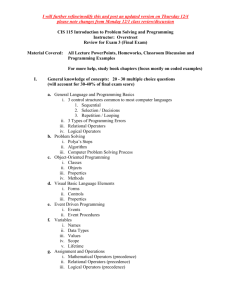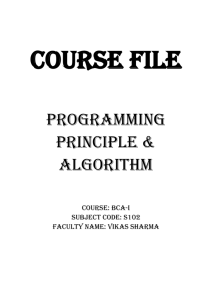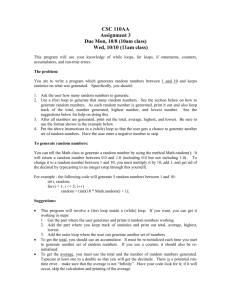Logical operators
advertisement

Chapter 6
Programming in MATLAB
MATLAB An Introduction With Applications, 5th Edition
Dr. Amos Gilat
The Ohio State University
Slide deck by
Dr. Greg Reese
Miami University
6.0
In this chapter will study how to
make MATLAB programs run
sections of code
▪If something is true
▪While something is true
▪For a certain number of times
2
6.0
Will also learn how to run different
sections of code depending on
▪The value of a variable
▪Which particular condition is true
▪What combination of conditions is true
▪ If this and that are true
▪ If this or that is true, etc.
▪What relationship two things have
▪ For example, one is less than the other;
greater than; equal to; not equal to; etc.
3
6.1 Relational and Logical Operators
Relational operator:
▪ Can't put space between operators that have
two characters
▪ "Not equal to" is "~=", not "!=" as in C or C++
▪ "Equal to" comparison is two equal signs
(==), not one.
▪ Remember, "=" means "assign to" or "put into"
4
6.1 Relational and Logical Operators
▪Result of comparing with a relational
operator is always "true" or "false"
▪ If "true", MATLAB gives the comparison a
value of one (1)
▪ If "false", MATLAB gives the comparison a
value of zero (0)
This may be different than
convention in other programming
languages. For example, C gives an
expression that is false a value of
zero, but it can give a true
expression any value but zero,
which you can't assume will be one
5
6.1 Relational and Logical Operators
When comparing arrays
▪They must be the same dimensions
▪MATLAB does an elementwise
comparison
▪Result is an array that has same
dimensions as other two but only
contains 1's and 0's
6
6.1 Relational and Logical Operators
When comparing array to scalar
▪MATLAB compares scalar to
every member of array
▪Result is an array that has same
dimensions as original but only
contains 1's and 0's
7
6.1 Relational and Logical Operators
Example
>> x=8:12
x =
>> x>10
ans =
>> x==11
ans =
>> x>=7
ans =
8
9
10
11
12
0
0
0
1
1
0
0
0
1
0
1
1
1
1
1
8
6.1 Relational and Logical Operators
It helps to picture in your mind that the
result of a logical comparison
TIP
1. Is a vector
2. Has a 0 or 1 corresponding to each original
element
>> x=8:12
x =
8
9
10
11
12
0
0
0
1
1
>> x>10
ans =
9
6.1 Relational and Logical Operators
TIP
If results of relational comparison
stored in a vector, can easily find
the number of elements that satisfy
that comparison, i.e., that are true,
by using sum command, which
returns sum of vector elements
▪Works because elements that are true
have value of one and false elements
have value zero
10
6.1 Relational and Logical Operators
TIP
EXAMPLE
How many of the numbers from 120 are prime?
▪Use MATLAB isprime command,
which returns true (1) is number is
prime and false (0) if it isn't
>> numbers = 1:20;
>> sum( isprime(numbers) )
ans =
8
11
6.1 Relational and Logical Operators
Can mix relational and arithmetic
operations in one expression
TIP
▪Arithmetic operations follow usual
precedence and always have higher
precedence than relational operations
▪Relational operations all have equal
precedence and evaluated left to right
12
6.1 Relational and Logical Operators
A logical vector or logical array is a
vector/array that has only logical
1's and 0's
▪1's and 0's from mathematical
operations don't count
▪1's and 0's from relational comparisons
do work
▪First time a logical vector/array used
in arithmetic, MATLAB changes it to a
numerical vector/array
13
6.1 Relational and Logical Operators
Can use logical vector to get actual
values that satisfy relation, not just
whether or not relation satisfied.
Doing this is called logical indexing or
logical subscripting
▪Do this by using logical vector as index in
vector of values. Result is values that
satisfy relation, i.e., values for which
relationship are 1
▪ NOTE – technique doesn't quite work with
arrays. Won't discuss that case further
14
6.1 Relational and Logical Operators
EXAMPLE
What are the numbers from 1-10 that are
multiples of 3?
>> numbers = 1:10
numbers
= 1 2 3 4 5 6 7 8 9 10
>> multiples = rem( numbers, 3 ) == 0
multiples = 0 0 1 0 0 1 0 0 1 0
>> multiplesOf3 = numbers(multiples)
multiplesOf3 =
3 6 9
15
6.1 Relational and Logical Operators
Example
Think of numbers(multiples) as
pulling out of numbers all elements that
have a 1 in the corresponding element of
multiples
numbers
= 1
2
3
4
5
6
7
8
9 10
multiples = 0
0
1
0
0
1
0
0
1
numbers(multiples) =
3
6
0
9
16
6.1 Relational and Logical Operators
EXAMPLE
What are the prime numbers from 1-20?
>> numbers = 1:20;
>> numbers( isprime(numbers) )
ans =
2
3
5
7
11
13
17
19
Logical indexing is particularly useful
when used with logical operators,
discussed next
17
6.1 Relational and Logical Operators
Logical operators:
Boolean logic is a system for
combining expressions that are either
true of false.
▪MATLAB has operators and
commands to do many Boolean
operations
▪Boolean operations in combination
with relational commands let you
perform certain types of
computations clearly and efficiently
18
6.1 Relational and Logical Operators
A truth table defines the laws of Boolean
logic. It gives the output of a logical
operation for every possible
combination of inputs. The truth table
relevant to MATLAB is
19
6.1 Relational and Logical Operators
In words, the truth table says
▪AND is true if both inputs are true,
otherwise it is false
▪OR is true if at least one input is true,
otherwise it is false
▪XOR (exclusive OR) is true if exactly
one input is true, otherwise it is false
▪NOT is true if the input is false,
otherwise it is false
20
6.1 Relational and Logical Operators
An arithmetic operator, e.g., + or -, is a
symbol that causes MATLAB to
perform an arithmetical operation
using the numbers or expressions on
either side of the symbol
Similarly, a logical operator is a character
that makes MATLAB perform a logical
operation on one or two numbers or
expressions
21
6.1 Relational and Logical Operators
MATLAB has three logical operators: &, |, ~
▪a&b does the logical AND operation on a and b
▪a|b does the logical OR operation on a or b
▪~a does the logical NOT operation on a
▪Arguments to all logical operators are numbers
▪ Zero is "false"
▪ Any non-zero number is "true"
▪Result (output) of logical operator is a logical
one (true) or zero (false)
22
6.1 Relational and Logical Operators
When using logical operator on arrays
▪They must be the same dimensions
▪MATLAB does an element-wise evaluation
of operator
▪Result is an array that has same
dimensions as other two but only contains
1's and 0's
(not only operates on one array so the
first point is irrelevant)
23
6.1 Relational and Logical Operators
When operating with array and scalar
▪MATLAB does element-wise
operation on each array element with
scalar
▪Result is an array that has same
dimensions as original but only
contains 1's and 0's
24
6.1 Relational and Logical Operators
Can combine arithmetic, relational
operators, and logical operators.
Order of precedence is
25
6.1 Relational and Logical Operators
EXAMPLE
Child – 12 or less years
Teenager – more than 12 and less than 20
years
Adult – 20 or more years
>> age=[45 47 15 13 11]
age =
45
47
15
13
11
26
6.1 Relational and Logical Operators
EXAMPLE
Who is a teenager?
>> age=[45 47 15 13 11];
>> age>=13
ans =
1
1
1
1
0
0
0
1
1
1
1
1
0
>> age<=19
ans =
>> age>=13 & age<=19
ans =
0
0
These mark the two teenagers
27
6.1 Relational and Logical Operators
EXAMPLE
>> age=[45 47 15 13 11]
age = 45
47
15
13
11
0
1
0
1
Who is not a teenager?
>> ~(age>=13 & age<=19)
ans =
1
1
0
Who is an adult or a child?
>> age>19 | age<13
ans =
1
1
0
28
6.1 Relational and Logical Operators
Built-in logical functions:
MATLAB has some built-in functions
or commands for doing logical
operations and related calculations.
Three are equivalent to the logical
operators
▪and(A,B) – same as A&B
▪or(A,B) – same as A|B
▪not(A) – same as ~A
29
6.1 Relational and Logical Operators
MATLAB also
has other
Boolean
functions
30
6.2 Conditional Statements
A conditional statement is a
command that allows MATLAB to
decide whether or not to execute
some code that follows the
statement
▪Conditional statements almost always
part of scripts or functions
▪They have three general forms
▪ if-end
▪ if-else-end
▪ if-elseif-else-end
31
6.2.1 The if-end Structure
A flowchart is a diagram that shows
the code flow. It is particularly
useful for showing how conditional
statements work. Some common
flowchart symbols are
▪represents a sequence of
commands
▪represents an if-statement
▪shows the direction of code
execution
32
6.2.1 The if-end Structure
If the conditional expression is true,
MATLAB runs the lines of code that
are between the line with if and the
line with end. Then it continues with
the code after the end-line
33
6.2.1 The if-end Structure
If the conditional expression is false,
MATLAB skips the lines of code that are
between the line with if and the line
with end. Then it continues with the
code after the end-line
34
6.2.1 The if-end Structure
The conditional expression is true if it
evaluates to a logical 1 or to a non-zero
number. The conditional expression is
false if it evaluates to a logical 0 or to a
numerical zero
35
6.2.2 The if-else-end Structure
if-else-end structure lets you execute
one section of code if a condition is true
and a different section of code if it is false.
EXAMPLE - answering your phone
if the caller is your best friend
talk for a long time
else
talk for a short time
end
36
6.2.2 The if-else-end Structure
Fig. 6-2 shows the code and the
flowchart for the if-else-end
structure
37
6.2.3 The if-elseif-else-end Structure
if-elseif-else-end structure lets you
choose one of three (or more) sections of
code to execute
EXAMPLE - answering your phone
if the caller is your best friend
talk for a long time
elseif the caller is your study-mate
talk until you get the answer to the hard problem
else
say you'll call back later
end
38
6.2.3 The if-elseif-else-end Structure
Can have as many elseif statements as you want
EXAMPLE
if the caller is your best friend
talk for a long time
elseif the caller is a potential date
talk for a little bit and then set a time to meet
elseif the caller is your study-mate
talk until you get the answer to the hard problem
elseif the caller is your mom
say you're busy and can't talk
else
have your room-mate say you'll call back later
end
39
6.2.3 The if-elseif-else-end Structure
Fig. 6-3 shows the code and the flowchart
for the if-elseif-else-end structure
40
6.2.3 The if-elseif-else-end Structure
Can omit else statement
▪In this case, if no match to ifor elseif-statements, no code
in structure gets executed
41
6.3 The switch-case Statement
if-elseif-else-end structure
gets hard to read if more than a few
elseif statements. A clearer
alternative is the switch-case
structure
▪switch-case slightly different
because choose code to execute
based on value of scalar or string,
not just true/false
42
6.3 The switch-case Statement
Concept is
switch name
case 'Bobby'
talk for a long time
case 'Susan'
talk for a little bit and then set a time to meet
case 'Hubert'
talk until you get the answer to the hard problem
case 'Mom'
say you're busy and can't talk
otherwise
have your room-mate say you'll call back later
end
43
6.3 The switch-case Statement
44
6.3 The switch-case Statement
switch evaluates
switch-expression
▪If value is equal to
value1, executes
all commands up to
next case,
otherwise,
or end statement, i.e., Group 1
commands, then executes code after
end statement
▪If value is equal to value2, same as
above but Group 2 commands only
▪Etc.
45
6.3 The switch-case Statement
▪If switch-expression not
equal to any of values in
case statement,
commands after
otherwise executed. If
otherwise not present,
no commands executed
▪If switch expression matches more than one
case value, only first matching case
executed
46
6.3 The switch-case Statement
TIP
Comparisons of text strings are casesensitive. If case values are text
strings, make all values either lower
case or upper case, then use upper or
lower command to convert switch
expression
caller = lower( name );
switch caller
case 'bobby'
some code
case 'susan'
some code
case 'mom'
some code
end
47
6.4 Loops
A loop is another method of flow
control. A loop executes one set of
commands repeatedly. MATLAB
has two ways to control number of
times loop executes commands
▪Method 1 – loop executes commands a
specified number of times
▪Method 2 – loop executes commands as
long as a specified expression is true
48
6.4.1 for-end Loops
A for-end loop (often called a forloop) executes set of commands a
specified number of times. The set
of commands is called the body of
the loop
49
6.4.1 for-end Loops
Body of loop
▪The loop index variable can have any
variable name (usually i, j, k, m, and n
are used)
▪ i and j should not be used when working
with complex numbers. (ii and jj are good
alternative names)
50
6.4.1 for-end Loops
1. Loop sets k to f,
and executes
commands between
for and the end commands,
i.e., executes body of loop
2. Loop sets k to f+s, executes body
3. Process repeats itself until k > t
4. Program then continues with
commands that follow end command
▪f and t are usually integers
▪s usually omitted. If so, loop uses
increment of 1
Body of loop
51
6.4.1 for-end Loops
Body of loop
▪Increment s can be negative
▪ For example, k = 25:–5:10 produces four
passes with k = 25, 20, 15, 10
▪If f = t, loop executes once
▪If f > t and s > 0, or if f < t and
s < 0, loop not executed
52
6.4.1 for-end Loops
Body of loop
▪If values of k, s, and t are such that k
cannot be equal to t, then
▪ If s positive, last pass is one where k has largest
value smaller than t
▪ For example, k = 8:10:50 produces five
passes with k = 8, 18, 28, 38, 48
▪ If s is negative, last pass is one where k has
smallest value larger than t
53
6.4.1 for-end Loops
Body of loop
▪In the for command k can also be assigned
specific value (typed in as a vector)
▪ For example: for k = [7 9 –1 3 3 5]
▪In general, loop body should not change
value of k
▪Each for command in a program must
have an end command
54
6.4.1 for-end Loops
Body of loop
▪Value of loop index variable (k) not
displayed automatically
▪ Can display value in each pass (sometimes
useful for debugging) by typing k as one of
commands in loop
▪When loop ends, loop index variable (k)
has value last assigned to it
55
6.4.1 for-end Loops
Output
EXAMPLE
Script
for k=1:3:10
k
x = k^2
end
k =
1
x =
1
k =
4
x = 16
k =
7
x = 49
k = 10
x = 100
After loop k = 10
fprintf('After loop k = %d\n', k);
56
6.4.1 for-end Loops
Can often calculate something
using either a for-loop or
elementwise operations.
Elementwise operations are:
▪Often faster
▪Often easier to read
▪More MATLAB-like
TIP
GENERAL ADVICE – use
elementwise operations when
you can, for-loops when you
have to
57
6.4.2 while-end Loops
while-end loop used when
▪You don't know number of loop iterations
▪You do have a condition that you can test
and stop looping when it is false. For
example,
▪ Keep reading data from a file until you reach
the end of the file
▪ Keep adding terms to a sum until the
difference of the last two terms is less than a
certain amount
58
6.4.2 while-end Loops
1. Loop
evaluates
conditional-expression
2. If conditional-expression is true,
executes code in body, then goes
back to Step 1
3. If conditional-expression is false,
skips code in body and goes to
code after end-statement
59
6.4.2 while-end Loops
The conditional expression of a
while-end loop
▪Has a variable in it
▪ Body of loop must change value of variable
▪ There must be some value of the variable that
makes the conditional expression be false
60
6.4.2 while-end Loops
EXAMPLE
This script
x = 1
while x <= 15
x = 2*x
Makes this output
x =
1
x =
2
x =
end
4
x =
8
x =
16
61
6.4.2 while-end Loops
If the conditional expression never
becomes false, the loop will keep
executing... forever! The book calls
this an indefinite loop, but more
commonly referred to as an infinite
loop. Your program will just keep
running, and if there is no output
from the loop (as if often the case), it
will look like MATLAB has stopped
responding
62
6.4.2 while-end Loops
Common causes of indefinite loops:
▪No variable in conditional expression
distance1 = 1;
distance2 = 10;
distance3 = 0;
and distance2
while distance1 < distance2 distance1
never change
fprintf('Distance = %d\n',distance3);
end
63
6.4.2 while-end Loops
Common causes of indefinite loops:
▪Variable in conditional expression never
changes
minDistance = 42;
Typo – should be 10
distanceIncrement = 0;
distance = 0;
while distance < minDistance
distance=distance+distanceIncrement;
end
64
6.4.2 while-end Loops
Common causes of indefinite loops:
▪Wrong variable in conditional expression
changed
minDistance = 42;
delta = 10;
distance = 0;
while distance < minDistance
minDistance = minDistance + delta;
end
Typo – should be distance
65
6.4.2 while-end Loops
Common causes of indefinite loops:
▪Conditional expression never becomes false
minDistance = 42;
x = 0;
y = 0;
Typo – shouldn't be
any negative sign
while -sqrt( x^2+y^2 ) < minDistance
x = x + 1;
y = y + x;
end
66
6.4.2 while-end Loops
TIP
If your program gets caught in an
indefinite loop,
▪Put the cursor in the Command
Window
▪Press CTRL+C
67
6.5 Nested Loops and Nested Conditional Statements
If a loop or conditional statement is
placed inside another loop or
conditional statement, the former
are said to be nested in the latter.
▪Most common to hear of a nested loop,
i.e., a loop within a loop
▪ Often occur when working with twodimensional problems
▪Each loop and conditional statement
must have an end statement
68
6.5 Nested Loops and Nested Conditional Statements
EXAMPLE
69
6.6 THE break AND continue COMMANDS
The break command:
▪When inside a loop (for and while),
break terminates execution of loop
▪ MATLAB jumps from break to end
command of loop, then continues with next
command (does not go back to the for or
while command of that loop).
▪ break ends whole loop, not just last pass
• If break inside nested loop, only nested
loop terminated (not any outer loops)
70
6.6 The break and continue Commands
▪break command in script or function
file but not in a loop terminates
execution of file
▪break command usually used within
a conditional statement.
▪ In loops provides way to end looping if
some condition is met
71
6.6 The break and continue Commands
EXAMPLE
Script
while( 1 ) Trick – "1" is always true so it makes loop iterate forever!
name = input( 'Type name or q to quit: ', 's' );
if length( name ) == 1 && name(1) == 'q' If user entered only one
letter and it is a "q",
break; Only way to exit loop!
jump out of loop
else
fprintf( 'Your name is %s\n', name );
Otherwise print name
end
end
Output for inputs of "Greg", "quentin", "q"
Type
Your
Type
Your
Type
>>
name
name
name
name
name
or
is
or
is
or
q to quit: Greg
Greg
q to quit: quentin
quentin
q to quit: q
72
6.6 The break and continue Commands
The continue command:
Use continue inside a loop (for- and
while-) to stop current iteration and start
next iteration
▪ continue usually part of a conditional
statement. When MATLAB reaches continue
it does not execute remaining commands in
loop but skips to the end command of loop and
then starts a new iteration
73
6.6 The break and continue Commands
EXAMPLE
for ii=1:100
if rem( ii, 8 ) == 0
count = 0;
fprintf('ii=%d\n',ii);
continue;
end
% code
% more code
end
Every eight iteration
reset count to zero,
print the iteration
number, and skip the
remaining computations
in the loop
74








